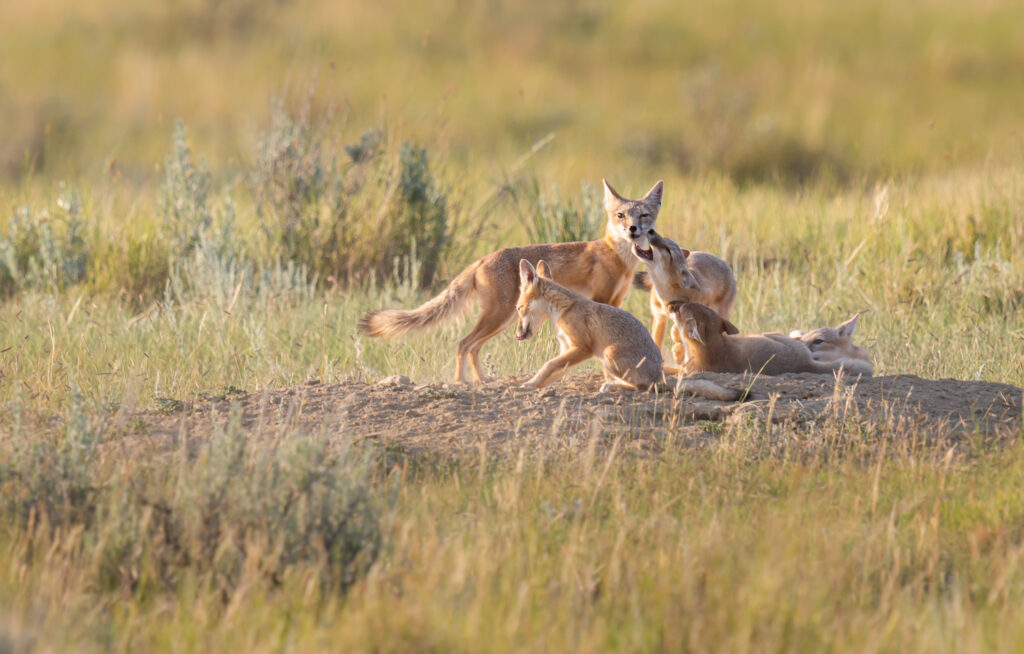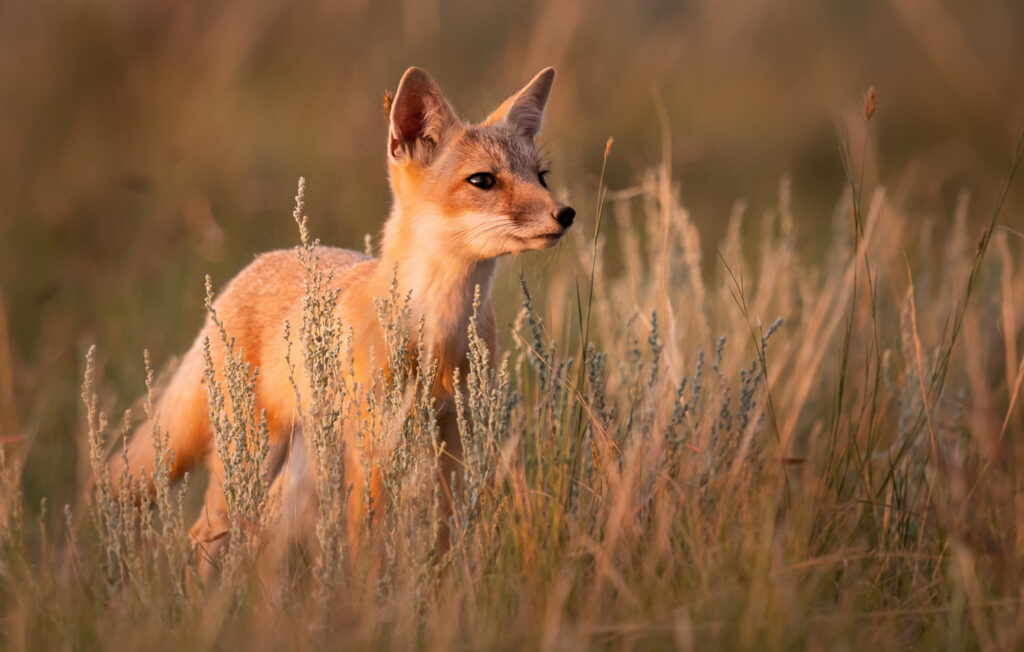| NEBRASAKA |
Once abundant, the smallest wild canine in North America is a little-known and vitally important member of the prairie and desert ecosystems of eastern Wyoming, central northern Colorado, and western Nebraska.
The elusive swift fox (Vulpes velox) earns its name by reaching speeds of up to 25 mph in pursuit of its prey, which consists of anything that doesn’t eat them first, including small mammals such as rabbits, mice, and prairie dogs, but also includes birds, fish, insects, small reptiles, and amphibians. They have also been known to eat berries, grass, and dead animals if possible. They can survive without standing water and rely on hydration from food alone.
Their speed is also vital in evading coyotes, the number one predator of swift foxes. Red foxes, eagles, great-horned owls, bobcats, and badgers also predate upon them.
This pint-sized predator weighs only 12 inches tall, 5-7 pounds, and 23-34 inches long from nose to tail, making it about the size of an average house cat. They are ⅕ the size of a coyote and ½ the size of a red fox, which they are often confused with. Red foxes can be distinguished by their black legs, white-tipped tail, and larger size.
During the summer months, the coats of swift foxes are short, rough, and reddish-orange on their backs, with a buff, to white, chest and belly and a long fluffy tail, tipped with black. In the winter, their coats become thick and luxurious, changing to a dark buff gray on their backs, with orange-tan fur on their sides, legs, and undersides of their tails. Swift foxes can also be identified by the distinctive black teardrop pattern on each side of their face, which descends from their inner eye alongside their nose.
These diminutive denizens of the short grass prairies of the Great Plains are primarily nocturnal and spend most of their daylight hours in or near their dens, emerging after sunset to hunt. They will dig their dens if necessary but prefer to save energy and enlarge the burrows of prairie dogs, badgers, or other animals.
A swift fox den can easily be located by the mounds of excavated earth in front of each entrance, usually 7-9 inches in diameter, and in a well-drained site such as a hilltop or sloping grassland. On rare occasions, they will set up housekeeping in dryland wheat fields, where the loamy, cultivated soil makes it easy for them to dig a suitable den for raising pups and evading predators. Unlike other canids, swift foxes use these dens year-round.
Swift foxes are monogamous and mate for life. The swift fox breeding season can begin anytime from late December to March, depending on how far north they are within their range. After about 51 days, anywhere from one to seven pups are born, relying on their parents until they are 4 to 6 months old when they disperse to start their lives as adult foxes. However, they will not breed and produce pups until they are 1-2 years old—their average lifespan in the wild ranges from four to six years.
| THE PLIGHT OF THE SWIFT FOX
In the early 1900s, their populations were decimated by trapping and poisoning from strychnine-laced baits meant for gray wolves and coyotes. While these practices have been discontinued, loss and degradation of the native short grass prairie that swift foxes rely on, along with livestock grazing and fire suppression, has made it difficult for them to persist. With increasing agriculture comes a substantial decrease in the short-grass prairie ecosystem. This, in turn, leads to the eradication of prairie dog towns. Without this significant food source and their burrows to provide cover from predators from both land and sky, the swift fox population has declined significantly.
Today, the swift fox only occupies approximately 40 percent of its historical range, stretching from New Mexico to southern Alberta and Saskatchewan. In Nebraska, the population only exists in the Panhandle and the southwestern corner of the state and has been placed on the state’s endangered species list. However, the federal government does not consider it threatened or endangered. In Wyoming, the tiny canines are growing in numbers and expanding their range, having been sighted as far west as Pinedale, and are considered a “species of greatest conservation need.” Some Wyoming foxes have been relocated in recent years and used to repopulate their former ranges in Southeastern Montana, where the species was nearly wiped off of the map in the last century.

| CREDITS & RESEARCH
Suppose you are lucky to see one of these rare foxes while adventuring through western Nebraska. In that case, the sighting should be reported to the Nebraska Game & Parks Commission, which conducts yearly surveys of the swift fox population at +1-(402)-471-0641.
In Wyoming, you can report sightings, along with any photos or videos that you have taken, to the Wyoming Game & Fish Department at wgf-rareanimal@wyo.gov
Story by: Kathrine Rupe
Photography by: Hawk Buckman







